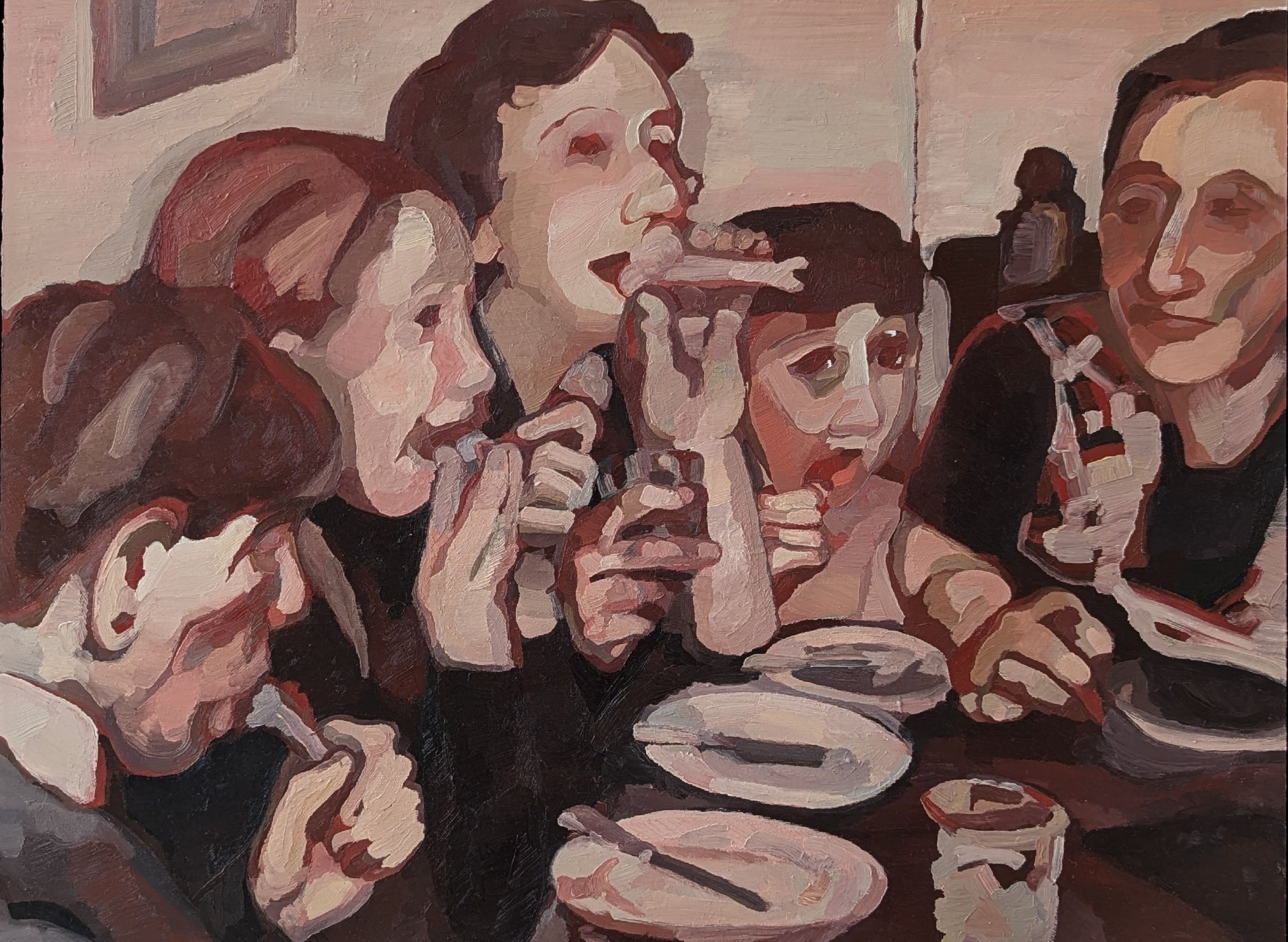EMMA WINDSOR LISCOMBE
Emma Windsor Liscombe is an interdisciplinary artist primarily working in painting, drawing, and site-specific installation. Her work explores the complexities of the human experience through figurative scenes, portraits, and landscapes. Themes of trauma, addiction, women's lives, myth, and the ongoing erosion of biodiversity intertwine in her practice, reflecting a deep engagement with the zeitgeist - a socio-political landscape marked by ambiguity, longing for home, and a search for meaning in challenging times.
Liscombe's paintings and drawings weave visual stories representing scenes of people and their lives - known and unknown, mythic or historical, personal and observed. Often imbued with an ambiguity of emotion, atmosphere, place, and character, the work invites viewer participation in the unfolding narrative. This open-endedness is key in a socio-political atmosphere of divide and confusion.
Drawing inspiration from ancient masks, Liscombe depicts characters with multifaceted emotions and expressions. This is particularly evident in her series examining women's stories in ancient myth and drama, where specific female characters from her family, such as her late paternal grandmother, become visual 'actors' onto which she projects and infuses story. The actual lives of these women merge with ancient female protagonists, creating revisionist imagery that speaks to both the timeless and the contemporary.
Her current series, Prairie, draws from personal and historical source material, including images of people from parts of Canada and Wales, family photographs from the interwar years, and vintage documentary CBC footage. These narratives bear a visual familiarity that evokes a sense of nostalgia, placing figures in safe, home-like spaces that may no longer exist. The intentional ambiguity of place, time, and emotion creates a visual mood that invites viewers to project their own experiences onto the work.
In both Prairie and her contemporary mythologies, figures turn away, look into unknown spaces, or return the viewer's gaze, confronting idealistic fantasy while extending an invitation to look, yet never totally revealing themselves. Bodies move out of the confines of the panel, plunge into the earth, or rise from it, representing the combined apathy and energy of a global community searching for meaning, empowerment, safety, and home - often through reflection of an idealized past.
The dynamism of colour and tone forces both subject and landscape to become as connected as they are one, reflecting the complex relationship between individuals and their environments. Figures moving, dancing in lines or circles, symbolize the confusion and peace of the zeitgeist. The subtle disappearance of natural elements represent the concept of change. Red, a recurring motif, carries a polarity of meanings, reflecting the challenging contemporary political and social tensions a global community navigates. Yet, in Liscombe's work, it ultimately becomes a symbol of a loud cry of emotion and energy, muted within apparently calm scenes.
These semi-abstracted images allow viewers to project and receive emotion. The zeitgeist is defined through these narrative images: figures are adult and child at once, representative of no one gender or age. They inhabit the past and the present, are grotesquely postured yet beautifully painted, representing the social and political ambiguity that defines the moment and continually moving while also static.
Having recently completed her MFA at the Royal Academy in London, Liscombe's work has garnered international recognition. Her paintings have been exhibited in major cities including London, Vancouver, Toronto, and Frankfurt, with a notable solo show at the Fitzrovia Gallery, London. She has been recognized with prestigious awards and nominations, including being shortlisted for the Herbert Smith Freehills Portrait Award at the National Portrait Gallery (UK), the Travers Smith Art Programme Award, the Morrison Foerster Art Programme Award, and the Global Design Graduate Show Award in collaboration with Gucci. Her paintings grace notable collections such as the Rennie Collection, the Robyns Collection, and the Cowan Collection.
Liscombe seeks to foster connection and dialogue through her art, reminding us of the cyclical nature of history, the importance of memory, and the enduring power of storytelling in a world marked by uncertainty and change. Her paintings stand as a testament to the transformative potential of art.

Emma Windsor Liscombe, Birthday Party (cake), 2020, Oil on panel, 30 x 24 in

Emma Windsor Liscombe, Birthday Party (cake), 2020, Oil on panel, 30 x 24 in

Emma Windsor Liscombe, Reunion of the Family of Love, 2024, Oil on canvas, 36 x 48 in

Detail: Emma Windsor Liscombe, Reunion of the Family of Love, 2024, Oil on canvas, 36 x 48 in

Emma Windsor Liscombe, Birthday Party V, 2019, Oil on canvas, 36 x 36 in

Detail: Emma Windsor Liscombe, Birthday Party V, 2019, Oil on canvas, 36 x 36 in

Emma Windsor Liscombe, Bone Suckers (Paxos Island of Love), 2021, Oil on panel. 24 x 18 x 2 in

Emma Windor Liscombe, Bone Suckers (Paxos Island of Love), 2021, Oil on panel. 24 x 18 x 2 in

Emma Windsor Liscombe, NFB Part I, 2024, Oil on canvas, 48 x 72 in

Emma Windsor Liscombe, NFB Part II, 2024, Oil on canvas, 48 x 72 in

Emma Windsor Liscombe, NFB Part III, 2024, Oil on canvas, 48 x 72 in

Emma Windsor Liscombe, Zeigeist, 2024, Oil on panel, 35.5 x 48 in

Emma Windsor Liscombe, Return of the Family of Love, 2024, Oil on canvas, 36 x 36 in







